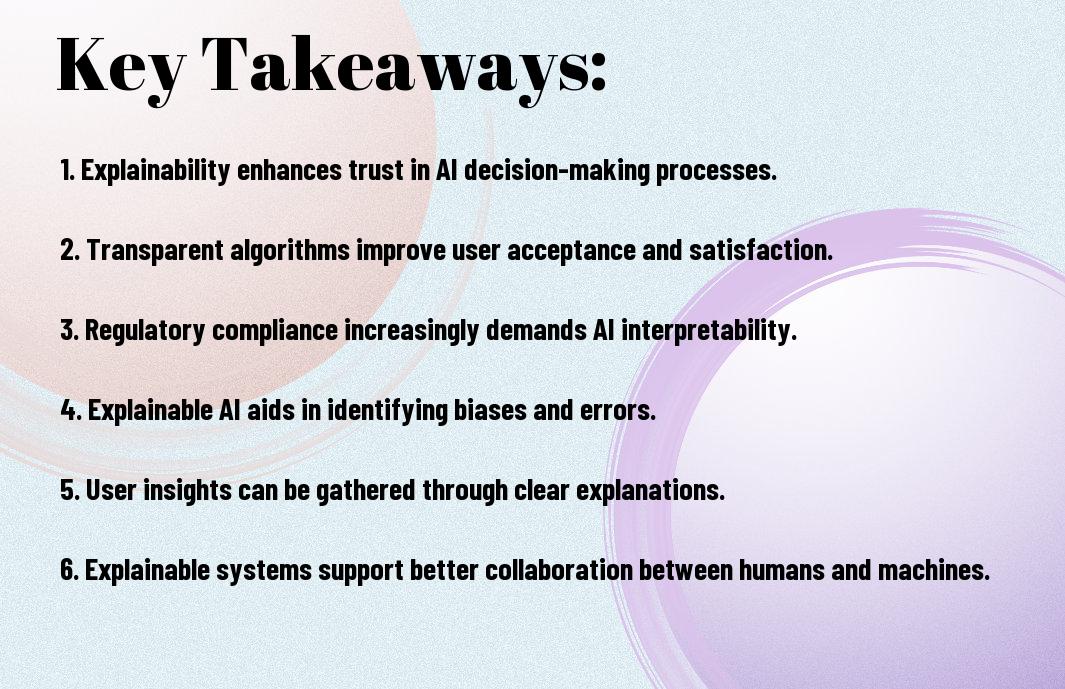As you examine into the world of artificial intelligence, you’ll notice that AI agents are becoming increasingly prevalent in your daily life. You’re likely to interact with them in various forms, from virtual assistants to autonomous vehicles. As AI agents make more decisions on your behalf, you need to understand the reasoning behind their actions. Your trust in these systems depends on their ability to provide transparent and interpretable explanations, making explainability a key aspect of AI development that you should be aware of.
Key Takeaways:
- The development of transparent AI systems is becoming increasingly significant, as explanatory models enable users to understand the decision-making processes behind artificial intelligence agents.
- As AI agents become more autonomous, the need for interpretability grows, allowing developers to identify potential biases and errors in the system.
- The implementation of explainable AI is necessary for building trust in AI systems, enabling users to make informed decisions and ensuring accountability in machine learning applications.
The Importance of Transparency in AI Systems
The increasing complexity of AI agents necessitates transparency in their decision-making processes, allowing you to understand how they arrive at their conclusions and take actions accordingly.
The Need for Explainable AI
About the growing demand for explainability, you should consider the benefits it provides, such as increased accountability and improved performance, which are important for your AI systems to be reliable and trustworthy.
The Role of Explainability in Building Trust
Transparency into AI decision-making is vital for establishing trust in your AI agents, as you need to comprehend the reasoning behind their actions to confidently rely on them.
Need to build trust in your AI systems drives the development of explainability, enabling you to identify potential biases and errors, and make informed decisions about their deployment and use, ultimately leading to more effective and responsible AI applications that you can trust and rely on.
Current Challenges in Achieving Explainability
Some of the obstacles you face in achieving explainability in AI agents are due to the complexity of the models and the lack of standardization in the field. You can find more information on Explainable Artificial Intelligence (XAI): What we know and what we can do in this article.
Complexity of AI Models
Alongside the increasing complexity of AI models, you are likely to encounter difficulties in interpreting their decisions, as the relationships between inputs and outputs become more intricate.
Lack of Standardization
Challenges arise when you try to compare and evaluate different explainability methods, as there is no common framework or set of standards to guide your assessment.
The lack of standardization in explainability also hampers your ability to develop and deploy AI models that are transparent and accountable, as different stakeholders may have varying expectations and requirements for explainability, making it difficult to establish a unified approach to achieving explainability in AI agents.

Techniques for Improving Explainability
After implementing AI agents in your systems, you’ll need to ensure that their decision-making processes are transparent and understandable. This can be achieved by utilizing various techniques that provide insights into the agents’ workings, enabling you to trust and rely on their outputs.
Model Interpretability Methods
For instance, you can employ model interpretability methods to analyze and understand how your AI agents function, allowing you to identify potential biases and areas for improvement, and make informed decisions about their development and deployment.
Feature Attribution Techniques
By utilizing feature attribution techniques, you can determine the contribution of each feature to the AI agent’s predictions, enabling you to refine your models and improve their performance, as well as ensure that they are fair and unbiased.
Feature attribution techniques are particularly useful in understanding how your AI agents weigh different factors when making decisions. You can use these techniques to analyze your models and identify the most influential features, allowing you to refine your models and improve their performance, and make more informed decisions about their development and deployment.
Applications of Explainable AI
Not surprisingly, Explainable AI has various applications across industries, enabling you to understand and trust the decisions made by AI agents, which is vital for your business and personal decisions.
Healthcare and Medicine
Towards achieving better patient outcomes, you can leverage Explainable AI to analyze medical data, identify patterns, and make informed decisions about your treatment options, allowing you to take control of your healthcare.
Finance and Business
For instance, you can apply Explainable AI in financial transactions, enabling you to understand the reasoning behind credit risk assessments, investment decisions, and other financial predictions, giving you more insight into your financial situation.
But as you examine deeper into the applications of Explainable AI in finance and business, you will discover that it can also help you identify biases in AI decision-making, allowing you to adjust and improve your business strategies, ultimately leading to more informed and transparent decision-making processes, which can benefit your organization in the long run.
Future Directions and Potential Solutions
To address the growing need for explainability in AI agents, you will need to explore new approaches and solutions that can provide transparency and accountability in AI decision-making.
Development of New Explainability Techniques
Explainability-driven methods will become vital for developing trustworthy AI agents, and you will need to invest in research that focuses on creating novel techniques for explaining complex AI decisions.
Integration with Emerging Technologies
Technological advancements in areas like edge computing and 5G networks will enable faster and more efficient AI processing, and you will need to consider how to integrate explainability into these emerging technologies to ensure transparency and reliability.
At this point, you may be wondering how to effectively integrate explainability into emerging technologies, and the answer lies in developing explainability techniques that can scale with the increasing complexity of AI systems, allowing you to build trust in your AI agents and ensure that they are aligned with your values and goals.
Implementation and Regulation
Now that explainability in AI agents is becoming increasingly important, you need to consider how to implement and regulate it in your organization. You will have to balance the need for transparency with the complexity of your AI systems, ensuring that your approaches are both effective and efficient.
Industry Adoption and Best Practices
Prior to implementing explainability in your AI agents, you should look at the approaches that other organizations in your industry are taking. You can learn from their experiences and adopt best practices that have been shown to be effective, tailoring them to meet your specific needs and goals.
Regulatory Frameworks and Guidelines
Following the development of your explainability strategy, you will need to ensure that it aligns with relevant regulatory frameworks and guidelines. You should familiarize yourself with the regulations that apply to your industry and region, and make sure that your approach meets all the necessary requirements.
A key aspect of regulatory frameworks and guidelines is the provision of standards for explainability in AI agents. As you develop your approach, you will need to consider these standards and ensure that your methods are compliant, allowing you to maintain trust and confidence in your AI systems. You should also be prepared to adapt to changes in regulations and guidelines, continually updating your approach to reflect new developments and expectations.

Summing up
Following this discussion, you can see that the importance of explainability in AI agents is growing rapidly. As you examine deeper into AI, you will find that understanding how these agents make decisions is vital for your trust in the technology. Your ability to interpret AI outcomes will become increasingly necessary, enabling you to make informed decisions and ensure accountability in AI-driven systems. You will need to prioritize explainability to unlock the full potential of AI in your applications.
FAQ
Q: What is explainability in AI agents and why is it becoming increasingly important?
A: Explainability in AI agents refers to the ability of artificial intelligence systems to provide transparent and understandable explanations of their decision-making processes and actions. As AI agents become more pervasive in various aspects of life, including healthcare, finance, and transportation, their decisions can have significant impacts on individuals and society. Therefore, explainability is becoming increasingly important to ensure that AI systems are trustworthy, fair, and accountable for their actions.
Q: How does the lack of explainability in AI agents affect their adoption and acceptance?
A: The lack of explainability in AI agents can lead to skepticism and mistrust among users, which can hinder their adoption and acceptance. When AI systems make decisions that are not transparent or understandable, it can be challenging for users to understand why certain actions were taken, leading to concerns about fairness, bias, and reliability. As a result, explainability is vital to build trust and confidence in AI systems, which is necessary for their widespread adoption and acceptance.
Q: What are some techniques used to achieve explainability in AI agents?
A: Several techniques are used to achieve explainability in AI agents, including model interpretability methods, such as feature importance and partial dependence plots, as well as model-agnostic explainability methods, such as saliency maps and attention visualizations. Additionally, techniques like model Explainability by Design (XBD) and transcript-based explanation methods are also being developed to provide more transparent and understandable explanations of AI decision-making processes.
Q: Can explainability in AI agents compromise their performance or efficiency?
A: While explainability can potentially add complexity to AI systems, it does not necessarily compromise their performance or efficiency. In fact, explainability can lead to better performance and efficiency in the long run by identifying biases, errors, and areas for improvement. Moreover, explainability can also facilitate the identification of potential issues before they become major problems, which can lead to more robust and reliable AI systems.
Q: What is the future of explainability in AI agents, and how will it impact the development of AI systems?
A: The future of explainability in AI agents is promising, with ongoing research and development focused on creating more transparent and understandable AI systems. As explainability becomes a standard requirement for AI systems, it will impact the development of AI in several ways, including the development of more interpretable models, the creation of explainability benchmarks and evaluation metrics, and the establishment of standards and regulations for explainable AI. Ultimately, the future of AI will depend on the ability to create trustworthy, fair, and transparent systems that can provide clear explanations for their actions and decisions.


